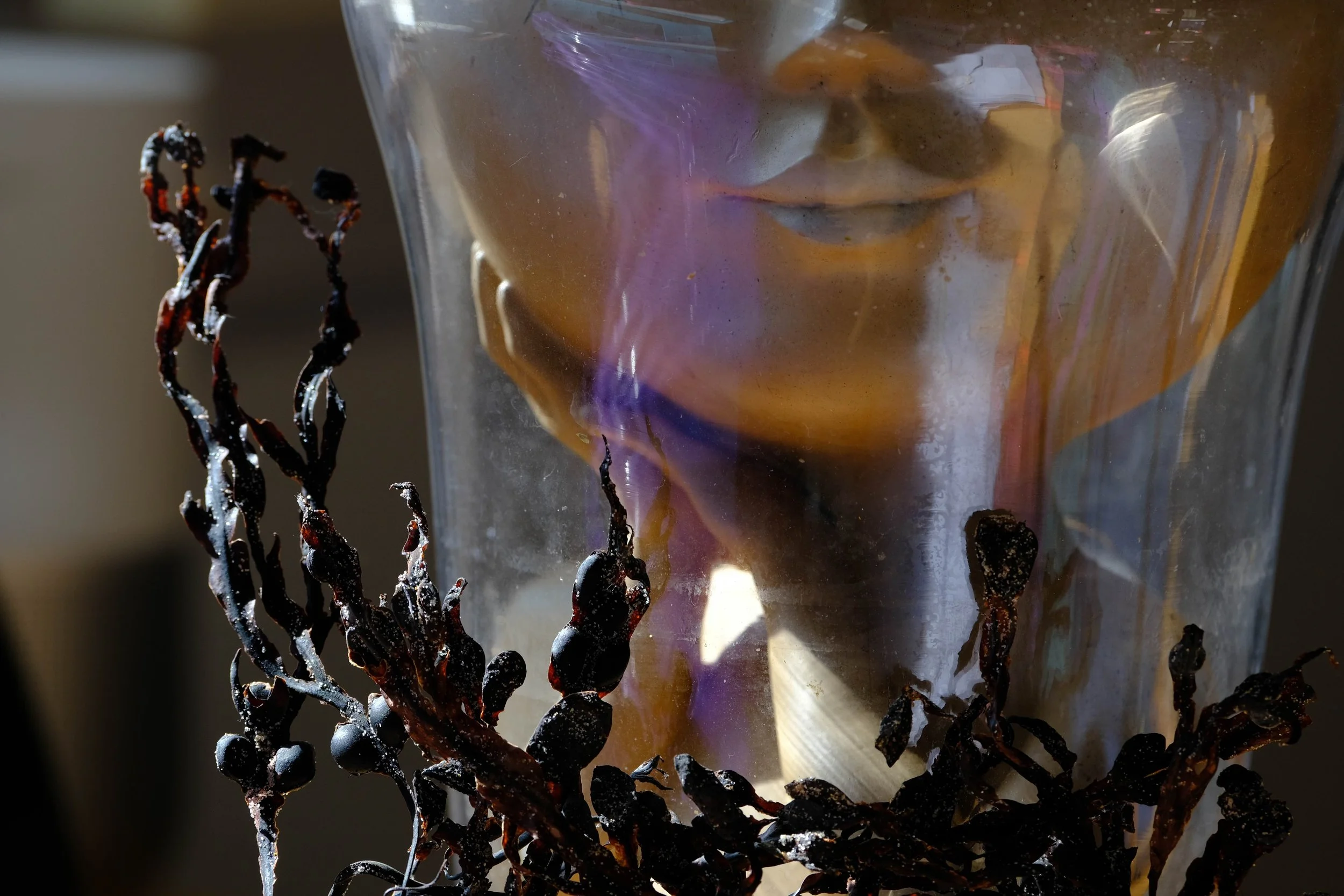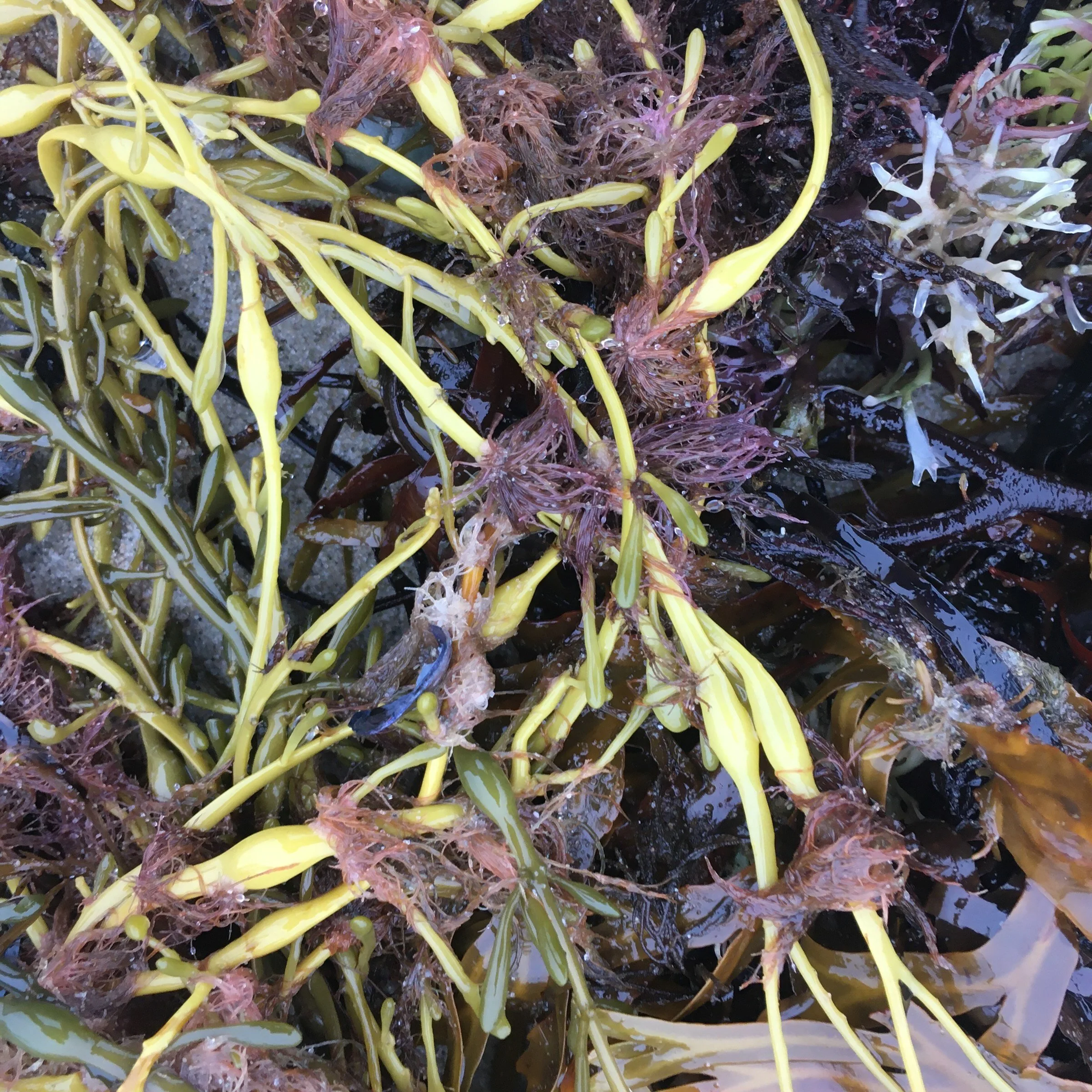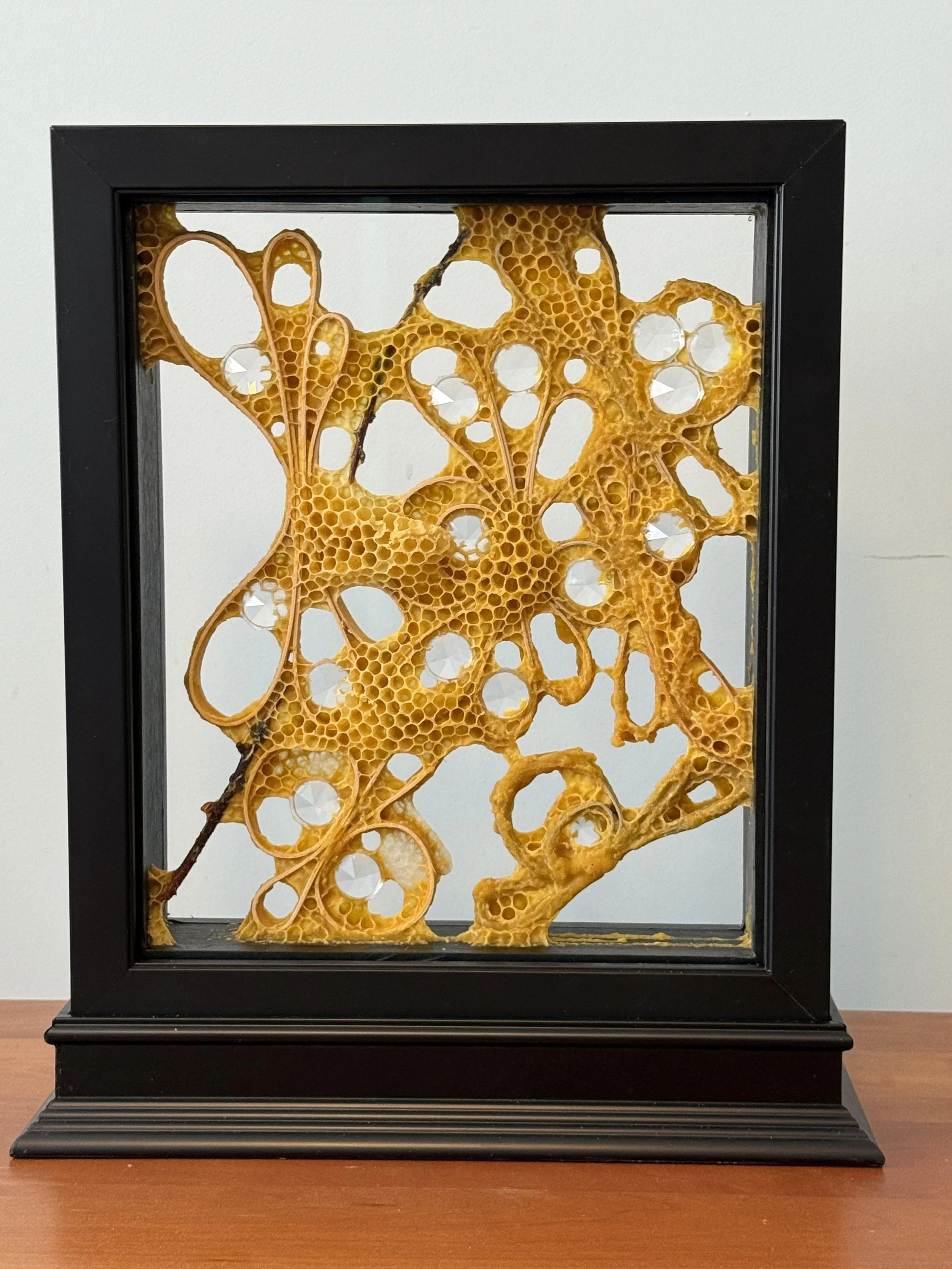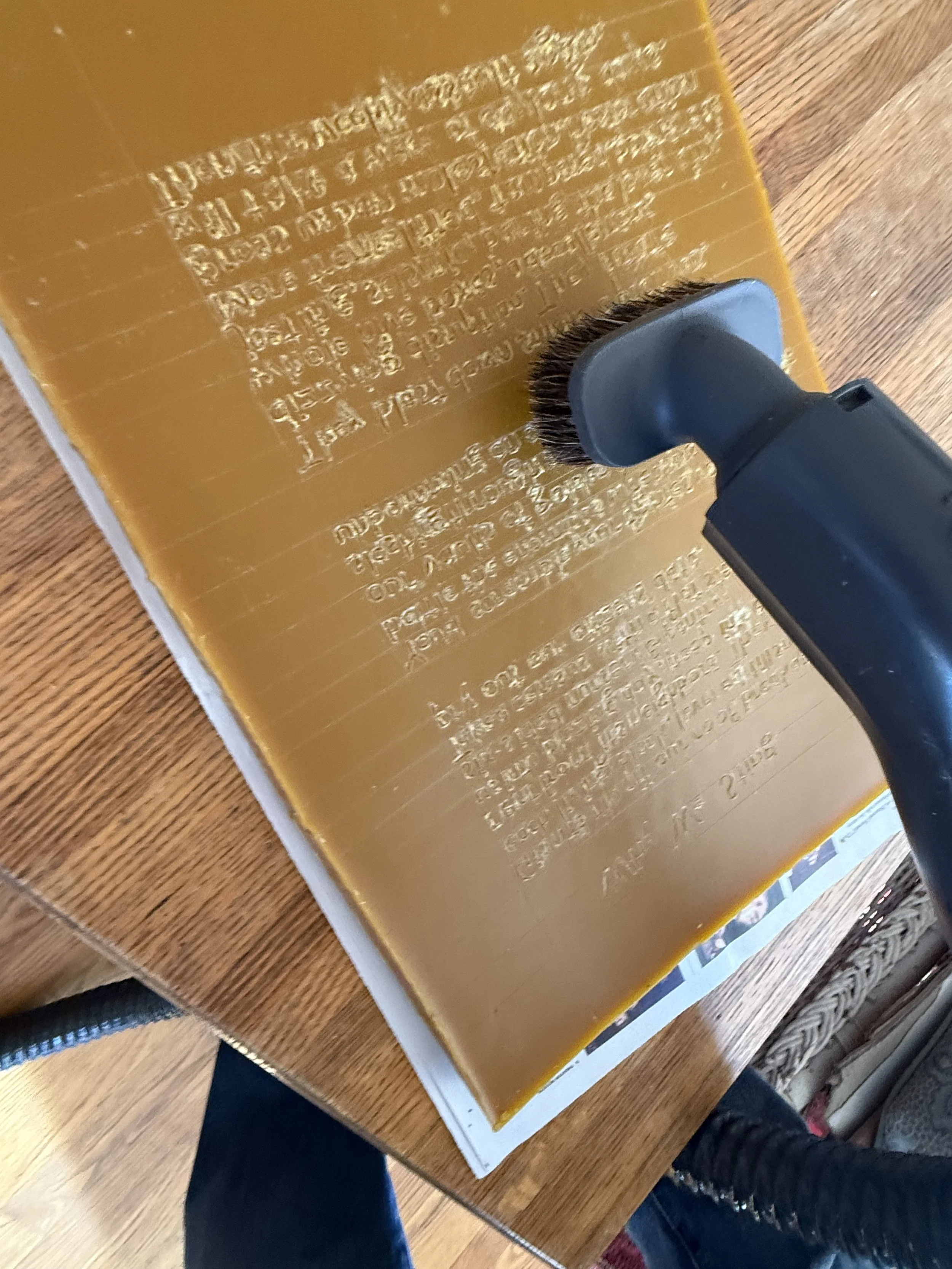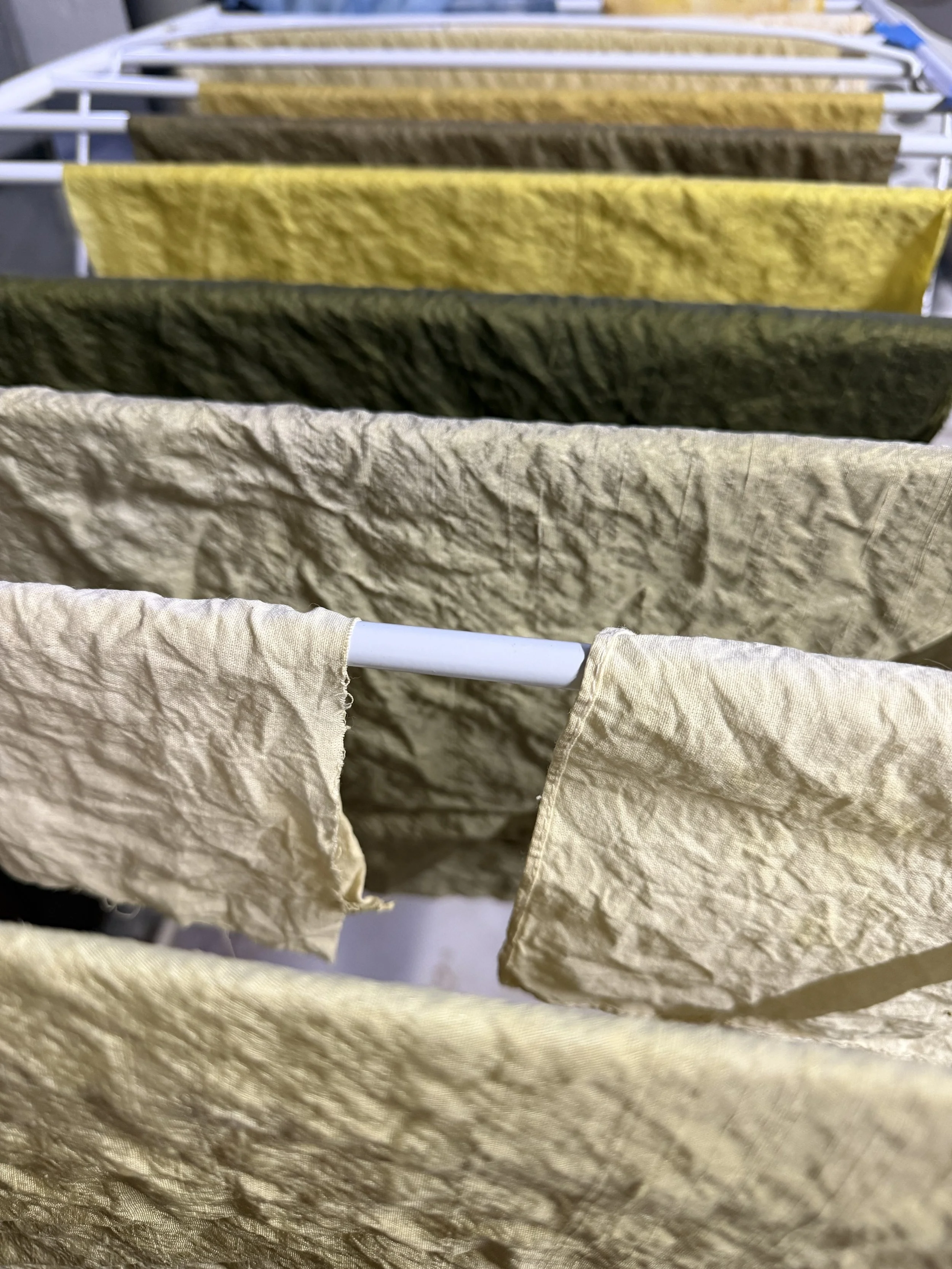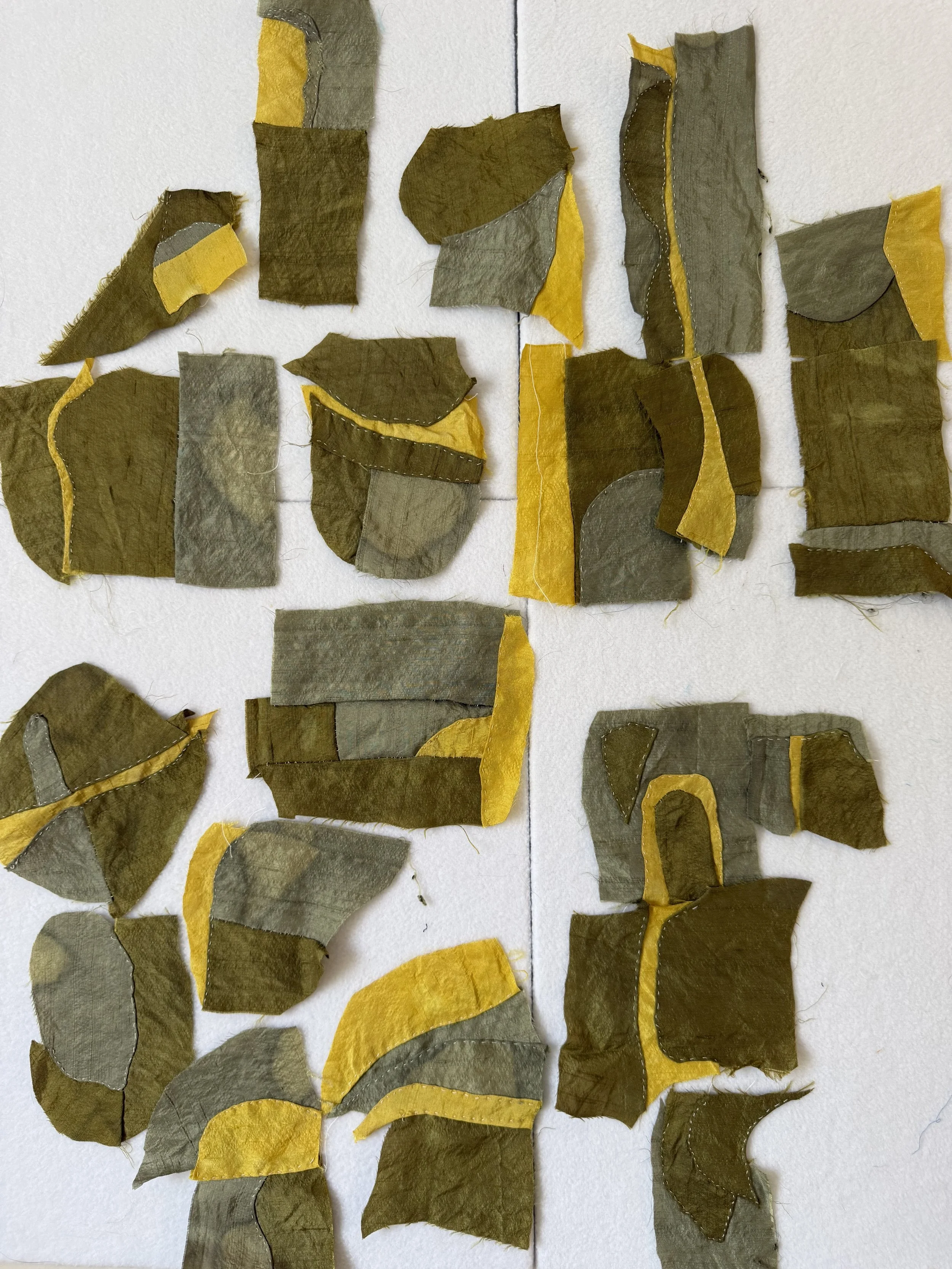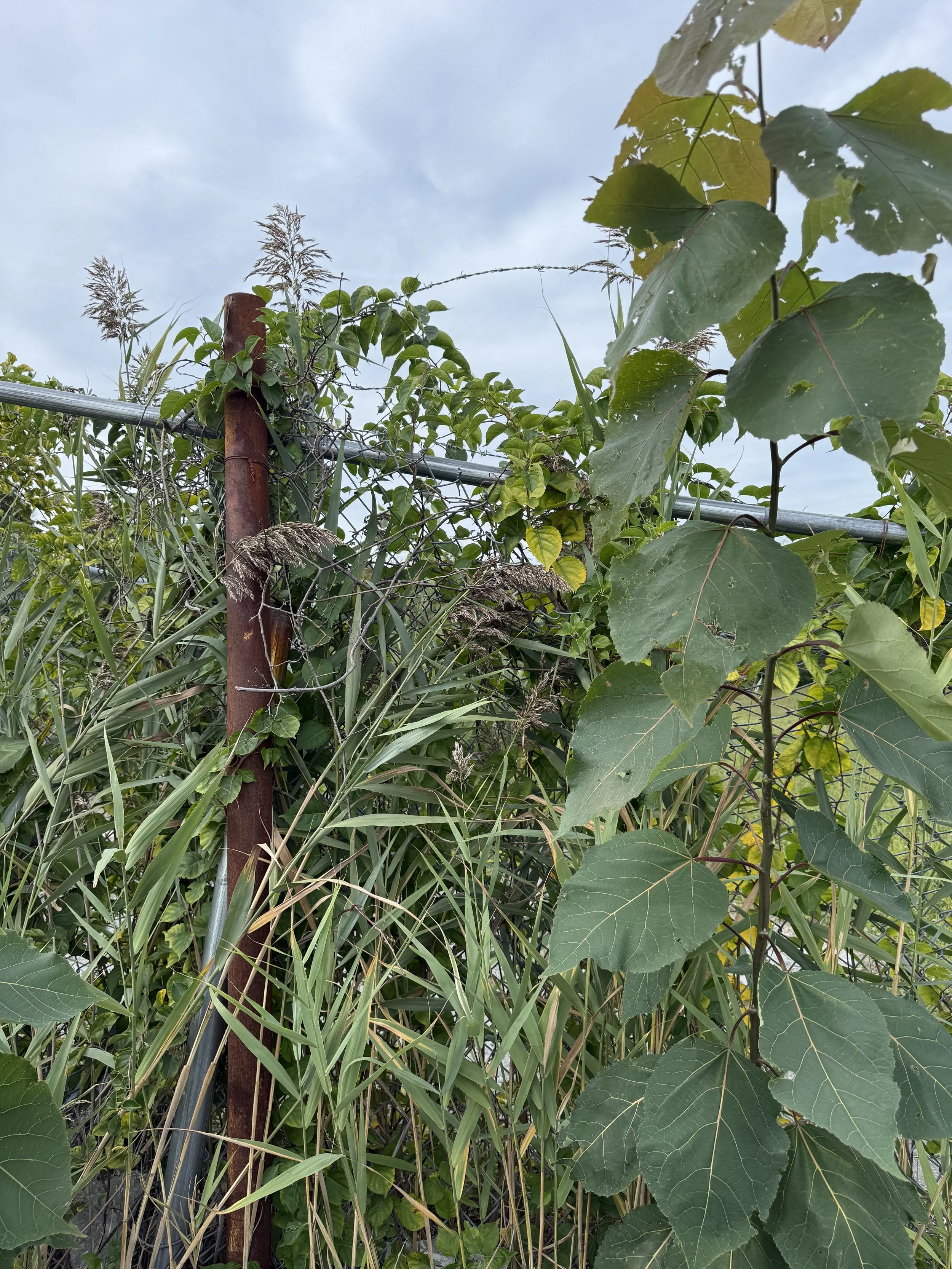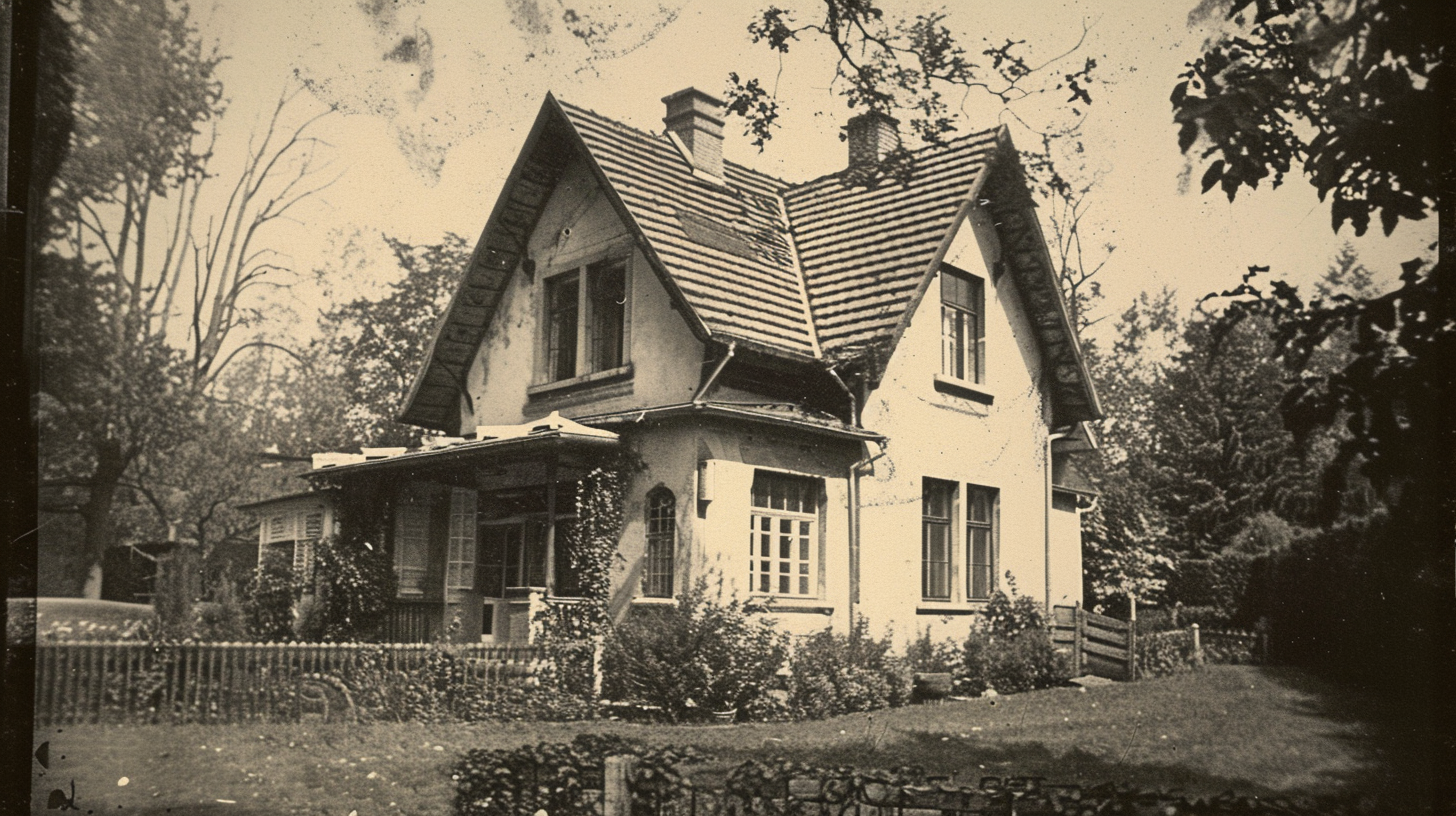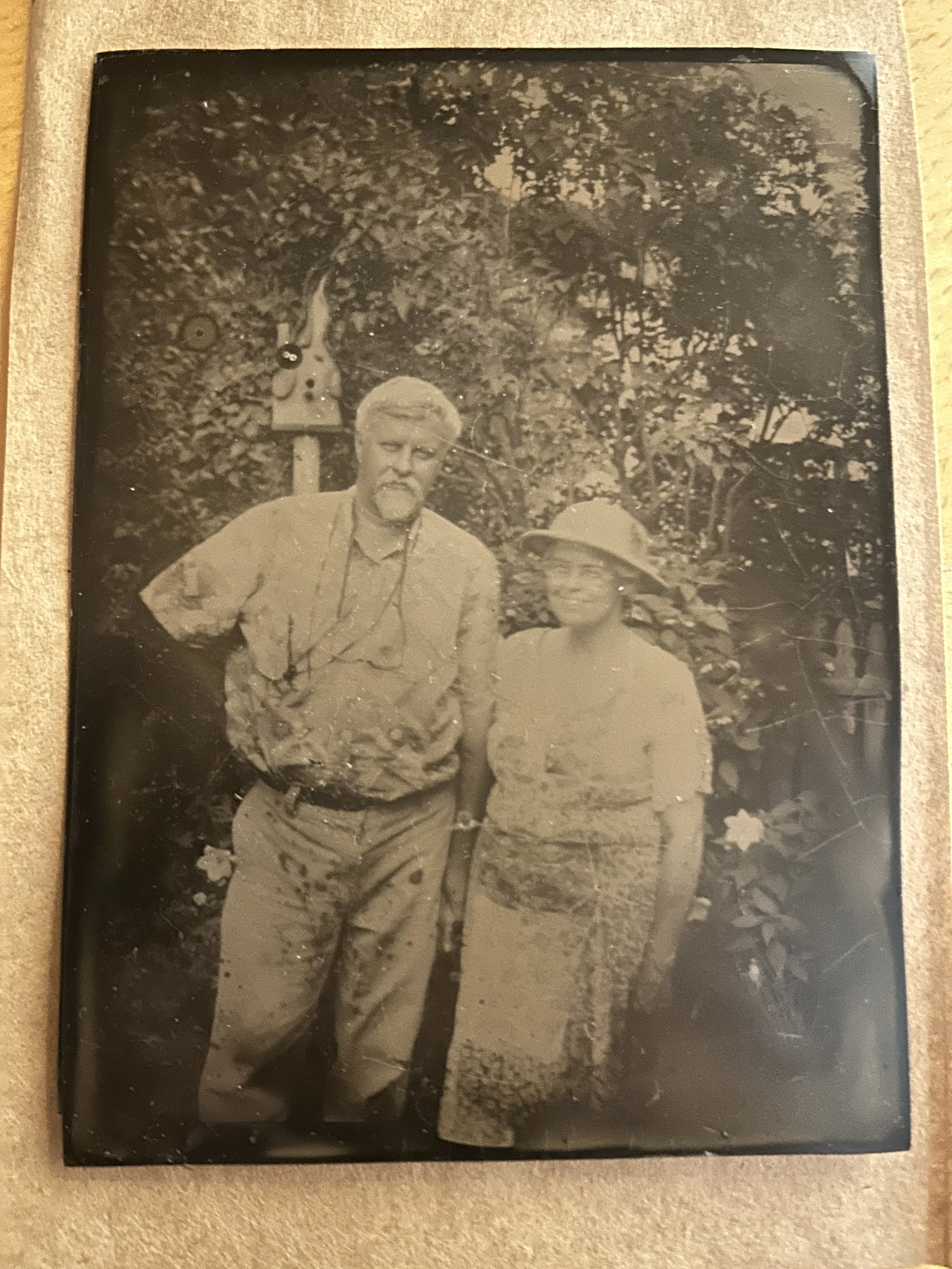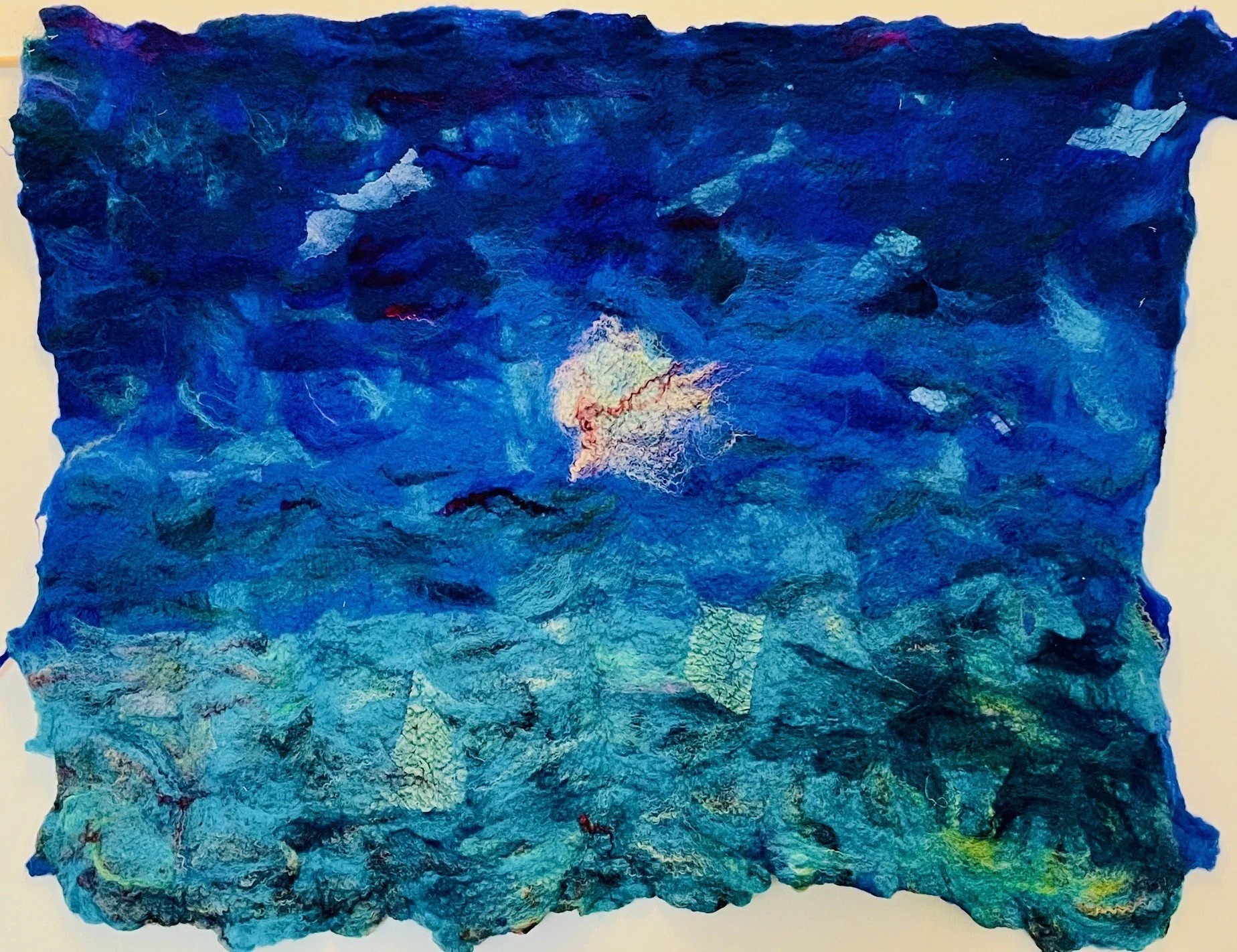A Celebration of Artistic Cross-Pollination
Creative Catalysts celebrates the interplay and creative exploration that happens when artists of different genres work together. From quilts that map out New Bedford to photographs of seaweed and homemade jigsaw puzzles, this innovative exhibition journeys through questions of perception, inspiration, and connection.
Krista:
"I wasn't sure what to expect when merging an abstract puzzle with a piece of writing. An artistic reflection? A futuristic hallucination? But Maija opted to keep her piece grounded, speculating about the prelude to travel. I wonder where her character is off to? A holiday? Visiting an ailing relative? Escape?"
Taking Off
by Maija McManus
She hops out of the Uber and looks around, finally able to breathe. Not often a person’s first impulse when at Logan airport, but the sense of adventure had been dormant in her for too long.
She looks up. The green of the parking garage on her left reminds her of pond scum. The building itself is pretty and well done, but still. Stationary cars in a towering structure that serve no purpose but to house them (even if it is ‘artsy’), left to sit while their owners go to Copenhagen or Shanghai. She’s sick of being stagnant.
Without another thought given to the architecture, she walks inside. It’s busy, but not crowded. No check in counter - carry-on only for her, traveling light this time. No overpreparing to compensate for someone else’s underpreparedness. She knows what she needs and where she’s going.
Through security, a process that becomes more and more scary each time she travels. She refuses the scan and is subjected to the indignity of a pat down from a woman who looks like her last smile happened in the 20th century. But she has plenty of time, and no one is waiting impatiently for her on the other side.
At last, the overpriced food court. A $25 teriyaki bowl - she asks for more chicken because the amount given was insulting. The teenager serving it looks at her questioningly but complies. You never get what you want if you don’t ask. It tastes like salt and not much else, but it will do the job until she reaches her destination.
Few things feel better than being in an airport all alone. The sense of possibility is endless. You could be anyone, going anywhere. This time, when the stranger at the bar strikes up a conversation, she’s a student heading to chase down a primary source for a master’s thesis. They chat while she sips her Sauvignon Blanc slowly.
Finishing up, she pays her tab and wanders into Hudson News to grab some gummy bears to chew instead of gum on takeoff. She heads toward the gate with plenty of time until boarding. The airport isn’t a race track, no point rushing if you don’t have to. This is just the way she likes to travel.
Book in hand, she pretends to read while people watching instead. Damn. She has to pee. This is the one part about flying alone, all your stuff has to come with you. Oh well. Off she goes. There’s a mother with a screaming child at the changing table who gives her an apologetic look. She smiles back as if to say “no worries, you’re doing great.”
Back to the gate, and it’s time to board. She hoists her duffel bag on her shoulder, boarding pass ready, and steps forward.
Maija:
"Krista's piece is so incredible. My medium is writing, and I like taking a nugget or a visual and turning it into a reflective piece. It's usually nature-based, but this one was obviously urban which was out of the norm, and was a lot of fun. I love imagining where this person is going!"
-
If you’ve flown in or out of Logan Airport in Boston, you may have noticed a couple of colorful window panels in the vicinity of Terminals B & C. Rainbow Cove Green, designed by artist Christopher Janney, reflects eight levels of the central parking garage (which was designed by Deborah Fennick of Fennick McCredie Architecture – I worked for Deborah Fennick 25+ years ago as her family’s nanny/personal chef, just as the 1998 central parking addition was completed, when I first moved to the Boston area). Installed in 2007, the massive glass wall reminiscent of a Tetris board includes accents of complimentary colors intended as “visual syncopation” with an additional audio component, an original composition by Janney entitled “Sound Environments of New England.”
I thought of none of this as I snapped a photo of the sunlit alcove one cold January day in 2019, on my way to Miami for a long weekend respite just after concluding cancer treatment. Bathed in the harmonic green glow of Jenney’s towering art, I felt a premonition of the verdant seasons to emerge from a drab New England winter. A year later, recovering from reconstructive surgery as the pandemic began, I pined for adventure and pored over old travel photos. As I rediscovered my obsession for jigsaw puzzles and began to design my own, this image reminded me of the colorful art deco architecture of Miami Beach. I altered the hues of the final image and designed the shapes of the pieces to imitate the palette and patterns popular on many retro countertops back in the day.
One of my favorite childhood treats was picking out a slice of chocolate cake with sprinkles from the rotating display at a roadside diner or airport eatery. Now, I can sit with a piece of homemade cake and a cup of tea and enjoy a classic puzzle.
The Rainbow Deco puzzle pieces were designed by the artist using Inkscape, an open-source vector graphic design tool, and cut with an FSL Muse 60 watt CO2 laser.
-
Maija McManus is a writer and development professional, originally from Boston and now rooted in the South Coast of Massachusetts. She often draws on nature and lived experience for her writing, weaving reflections that balance intimacy, clarity, and a deep sense of place.
A lifelong lover of words and stories, she is currently the Development Associate for The New Bedford Light, where she leads fundraising initiatives, builds donor relationships, and helps sustain nonprofit, nonpartisan journalism for the community. She is especially motivated by the role of independent journalism in strengthening democracy and civic life on the South Coast.
In her free time, Maija volunteers at Lighthouse Animal Shelter, practices yoga, and juggles more than one book club at a time. She also enjoys traveling, journaling, exploring local arts and culture, and sampling all the seafood this area has to offer.
__
It's hard to write an artist statement about a written piece! I saw Krista's beautiful piece and was having a hard time settling on what I wanted to do with my portion of this project. Realizing it was a building at Logan had me thinking back to the last time I was there - how I felt getting to leave the country. That feeling is always so exciting, no matter who you are, and I ended up using Krista's photo as a jumping off point to try and capture what it's like to strike out on your own.
-
Krista Allen Partner: Maija McManus
Rainbow Deco
8x8 in, wood
Krista Allen is an author & artist living in Westport, MA
Masks of the sea
11 x 5 in. and 7 x 5.5 in.
Clay Pottery
Masks by Rebecca Lesses
The larger of the two masks that I’m showing in the exhibition was in part inspired by the sea at Westport, and also by childhood memories of swimming on the Cape with my family and imagining myself as a sea creature. The other one was made last year and also has greenish and bluish tones of the sea in it.
Masks of Oceanic Royalty
by Mark Collins
These sculpted clay masks beautifully embody the mysteries which spring from the depths of our beloved South Coast waters. Just as the sea connects ancient geological time to present tidal moments, these masks bridge millennia—from 10,000-year-old Neolithic stone faces to contemporary clay forms glazed in the blues and greens of Buzzards Bay.
Rebecca's mask-making process mirrors the sea's own transformative power. She shapes each face upon a mold of her own creation. Like waves that reshape shorelines over time, the masks have evolved from Rebecca's skilled hands through multiple metamorphoses: faithful reproductions became fluid interpretations; carved details transformed into simple openings; blank spaces bloomed into lips and eyes which hold a captivating oceanic consciousness.
The clay itself, undergoes its own journey of fire and rebirth. Each mask is fired twice—first achieving the hardened state of bisque, then receiving its final glazed transformation. This dual firing echoes the dual nature of our coastal waters: the harsh reality of winter storms and the gentle caress of summer tides. Just as the blue and turquoise mask recalls the vibrancy of the summer seas, the paler mask portrays the cold yet crystal clear wintery waters we experience in the coldest days of the year.
The vision of the summer mask as a Queen of the sea, swimming off Westport's shore, accompanied by its crowned companion as King and ruler of underwater realms, evokes the timeless mythology of ocean deities. These ceramic faces seem to emerge from the same primordial waters that have spawned an eternal dialogue between human imagination with the sea's ancient, ever-changing presence.
The larger mask, created during Rebecca’s recent summer of inspiration, bears upon its brow a crown formed from an additional piece of clay impressed with the delicate veining of a Hosta leaf. This botanical touch grounds the mythological in the terrestrial, while the elongated forehead suggests both royal bearing and the streamlined form of creatures adapted to underwater realms. The blue and green glazes that flow across the crown and eyes capture not just color but the very essence of our coastal waters—from the deep jade of underwater kelp forests to the brilliant azure of the open ocean.
Its companion piece, born from the artist's hand a year prior, maintains the austere beauty of its ancient predecessors. With eyes that remain holes and a mouth rendered as a simple slit, it speaks to the original stone masks while wearing its own mantle of oceanic blues and turquoises.
Through Rebecca's skilled interpretation, these Masks of Oceanic Royalty become ambassadors from that underwater realm, bringing beauty and the ancient nobility of the sea to one and all who behold their majestic visages.
-
Mark Collins is an author and freelance writer, who writes about experiences of the natural world here in the beautiful natural environment of South Coast MA. His writing style is inspired by Rabindranath Tagore’s meditative naturalism, as well as Ralph Waldo Emerson’s poetic prose writing style. This is best described as translating our experience of divinity as expressed in the natural world while reflecting on recurring themes and images. Mark believes we can all find common ground in the transcendent beauty nature presents, which serves to connect us with both nature and each other. With a goal of fostering the movement of humanity from division and separation to oneness, unity and peace, he writes from the heart, the gateway to the soul. Mark is a published author of The Heartspace Portal book available on Amazon. His freelance experience also includes a column called Metaphysical View which was featured in Intrepid Magazine.
__
Rebecca's sculpted clay masks emerge from her vision of ancient craft traditions meeting our South Coast's ever-changing waters. Drawing inspiration from 10,000-year-old Neolithic stone faces, each piece bridges millennia through contemporary clay forms glazed in Buzzards Bay's distinctive blues and greens.
Rebecca's process mirrors the sea's transformative power. Like waves reshaping shorelines, these faces evolved through multiple metamorphoses—from faithful reproductions to fluid interpretations, carved details becoming simple openings, blank spaces blooming into lips and eyes holding oceanic consciousness. The clay undergoes dual firing: first achieving bisque hardness, then receiving final glazed transformation.
Rebecca's idea of a queen and king of the sea is perfect as the faces beam with noble elegance. I felt the other duality present would be one mask representing winter and the other summer, given the contrast of colors and expressions. What I love most is that even the austere wintery face is smiling. He knows the secret I've learned being a lifelong South Coast resident—that the sea retains its beauty in winter, offering a different yet enlivening experience to behold.
-
I’m a potter, living in Ithaca, New York. I began taking pottery lessons in 2016, first learning how to throw, and then how to make hand-built pieces. The pieces I make most frequently these days are clay masks. I was originally inspired to make them by a visit to the Israel Museum in Jerusalem some years ago, where I saw an exhibition on stone masks from the Neolithic era (about 10,000 years ago). These were masks that were about life size, carved from stone, with holes along the sides. The eyes were holes, and the mouths had carved stone teeth in them. I was very intrigued by the masks, and I brought the exhibition book home and started using it as a model for my own masks. At first, my goal was simply to copy the stone masks, in order to figure out how to make them, but then I started going on my own path with them.
The larger of the two masks that I’m showing in the exhibition was in part inspired by the sea at Westport, and also by childhood memories of swimming on the Cape with my family, and imagining myself as a sea creature. The other one was made last year and also has greenish and bluish tones of the sea in it.
-
Dying and Breathing Again
23 x 18 in.
Oil and natural materials on canvas
by Tessa Remy-Miller
Photographs
by Midori Evans
Midori:
I walk the paths, feet edging to the moments of toe-dipping, as the light flitters with the clouds. I walk each day, dragging my soul to the one thing that feeds me, spray and drama, ever-changing tides, murky water clearing, like my mood lifting, lifting until I can breathe again. I collect seaweed all in one day, an unfamiliar Cape beach, the bits of edible seagrass clotted at the high tide line, the bladderwrack singing as it swishes up and down at the edge of the shore. Other bits come along, the scallop shells, the whelk egg cases; clumps and strands dry in the wonderful, afternoon sunshine.
Midori: How, precisely, did we emerge with the seaweed theme? I was up in Portland, Maine attending the Art in Bloom exhibit, taking photos of colors and color books and palettes I find in the art museum store and texting them over to Tessa, my partner in Creative Catalysts. Her paintings are rich in color, often dramatic, drawing the eye immediately to this influx of emotion and vibrancy. So much of the work I do revolves around nature, both in my photography and my writing. We hadn’t landed, quite yet, on a theme though we both knew it would be nature-based. The next day I wander into a seaweed store, tucked away in the corner of the Old Town, full of gorgeous books on seaweed harvesting and seaweed cookbooks. Rich textures, the magnificent red of dulse, the infused black of dried kelp, the gorgeous curls of hijiki and the loveable reliability of nori green seaweed. Something clicked, the overlap and merging of color and something in the natural world I had not paid enough attention to. Seaweed? my one-word text read. What do you think? “I would be down with that.”
Theme settled.
-
I’ve been a photographer since age 16 when, while living in Tokyo, my parents bought me a small Konica camera for my birthday. Primarily self-taught, I’ve taken classes at Santa Fe Workshops, Maine Media Workshops, the International Center for Photography in NY, and the Fine Arts Work Center in Provincetown.
My photographic work focuses on exploring the hidden. Photographs emerge from the inside out, using color, water, flowers, and reflected light to explore our shared unknowns. Mystery, light, seeing spirituality, the moment of now? Capture the images that paint our emotional selves.
My work is at cedarlightimages.com and is integrated into Midori Creativity designs and presentations. I’ve exhibited my work in the 17th National Photography Competition Exhibition at fotofoto Gallery in Huntington, NY and this past month at the Westport Art Group’s 2025 Invitational Photography Exhibition. In addition, you can find my photographs and written work in the local South Coast anthologies, The Landscape About Us and Waterscapes.
__________________
Tessa challenges me: where are the people? Can you have a human being in your natural seaweed images, even a hand or an arm?
I drive through fields bordering the Westport River, a sunny, warm morning, sturdy boots on, camera at the ready. Rockweed gathering for the annual clambake commences and I am the only one staying dry. Flinging handfuls of seaweed, collection bags dragging through the water, I zoom, click, shoot.
-
Tessa Remy-Miller is a painter based in the South Coast of Massachusetts. She works with figurative subjects and colorful experimentation.
Ten years old, the feeling of seaweed tickling the soles of my feet, my body turns to slime underneath my skin. Twenty-seven, I am icing the canvas with delectable textures. I am in control of the gooey feeling rubbing across my legs. Vibrant underwater forests celebrate seaweed’s regeneration and practice hope. The natural world grows and decays but always continues.
I scooped the oil paint into a plastic bag, snipped one corner and piped it onto the canvas like frosting. A textural experience made with tendrils of earthy paint. Color after color squeezes through the same few bags and shares pieces of each other. That freedom in happenstance is something I celebrate. Pressing hydrangea petals into the paint to act as a held breath, frozen in their current state. Oil seeping into the petals and exposing their veins that match our own. Intuitive shapes all focused on finding balance, even while it may appear overwhelming.
-
Tessa Remy-Miller
@tessa_magee_art tessamageeart.com
Midori Evans
Contemplation 10.5 by 7 in.
Ess 7 by 10.5 in.
Longing 7 by 10.5 in.
Spirit 10.5 by 7 in.
Star Montage Panel of four images, each 4 x 4 in.
The Gathering 20 x 7.5 in.
-
Jennie Kristel grew up surrounded by books, art, and music intertwined: it was a deeply enriching upbringing that balanced the complexities of being raised in the long shadows of war and genocide, as well as profound assumptions of her physical capabilities.
She studied interpersonal communication, psychology, and theatre and received an M.A. in Expressive Arts Therapies and a Certificate in Deep Ecology. Since 1987, she has interwoven her artwork with work as an energy healer, teacher, and artist. Having worked in both clinical and non-clinical settings as an expressive arts therapist, utilizing multiple arts forms, she tries to help individuals and groups discover meaning, uncover and heal difficult truths, and enhance self-esteem. Her work has increasingly meant exploring issues of social and environmental justice from a variety of perspectives, including the understanding that the relationship with the natural landscape is a core human experience. Creating an artistic container for people to exist without repercussions is a core aspect of her work, examining how we live in a world often defined by marginalization, judgment, and assumptions.
We live in a beautiful, threatened place. This year, we again find ourselves in a summer drought; what just a few years ago would have been anomalous is now almost routine. Each spring, there seems to be less bird song, and each summer, fewer butterflies. At the same time, our government insists nothing is changing.
Our lives are dense weavings of place, memory, others, and story. Our work is a reflection upon this ancient truth. We go out into the world on a daily basis and notice the profound changes taking place in our landscape. The seasons are askew, and diversity and complexity are in precipitous decline. The words we might use to describe our threatened ecosystems and human communities are as threatened as the natural environment.
Our collaboration is an attempt to interweave the lived experiences of three generations and three cultures. Herein, there is nature and the people made environment. There is joy, sorrow, and perseverance. Interwoven throughout is the legacy of genocide and the evil of denial.
Within our work are images made and borrowed, words we wrote, and wordstaken from our ancestors. Within these pages are layers upon layers of lived experience: love, hope, fear, creativity, and joy. There are memories of landscapes loved and lost, and hopes that much may yet be saved. There are vows, promises, hopes, fears and observations about the lived moment from across decades and generations.
These pages are filled with the dangerous words and images that aid us in holding on to our connections to generations of family, the beauty and mystery of nature, the richness of our diverse cultures, and the deep truths that guide us in an age of lies.
As we finalize this artist's statement, we acknowledge that because it contains forbidden words, it would be barred from inclusion in any activity of the National Endowment for the Arts. As of the most recent count we have seen, there are almost three hundred forbidden words, including the words: “woman”, “disabled”, and “Native”, words essential to our identities.
-
Michael Watson is a visual, sound, and theatre artist living in Dartmouth, MA. In 2022 he retired from a career as a psychotherapist, and college teacher and administrator, in order to focus on his creative work. As a child he survived a catastrophic case of polio. His family Identified as Native, were not tribally affiliated, and passed as white. His art reflects his upbringing, love of nature and natural processes, and his immersion in, and commitment to, diverse communities and cultures. Michael is an internationally recognized shaman whose life and work are profoundly influenced by his family and traditional shamanic teachers. The Amazonian tribes and communities that generously shared their knowledge with him have been destroyed, a genocide supported by our government. Michael holds advanced degrees in studio arts, cross cultural counseling, and psychology and environmental studies. He blogs at https://dreamingtheworld.blog/
In creating Interweaving: Place and Memory, our first visual art collaboration, we wanted to explore memory and place, as it is a theme we often work with in our individual work. We began by playing off a book project that Jennie was exploring that uses strips of collaged paper with pictures and text. It was looking at the result of these pages that Jennie and Michael began to pull from their shared experiences of being weavers to literally weave the collage material together and create the pages. Early on, we decided we also wanted to compose sound for the project and have both contributed ideas to the sound composition as it has developed. -
[a bipartite ekphrastic poem for Susan Medyn]
Digital print or hand-lettered
Why We Sting
Giants rip off our roofs. They break apart
each living block, levered till they snap free,
rent from its neighbors. They hoist
us into blazing day, peep in every
six-sided pantry or nursery;
they census with a flat steel hook—
pry out our citizens’ data.
Injured, vengeful, you’d scramble your fighters too;
battle the enormous wreckers who rob
our vaults of golden goo in wax lattices;
slashing through male infant dormitories,
undamming an ooze of larval protein.
They blast jute smoke to “pacify”,
a dizzying disruption. They disorient
whole brood boxes, a décollement,
jostling, seismic; baring the lower city.
More frames lifted, tampered, bothered:
gross urban molestation. Restoration
takes a week of daylong days
before the weekly assault returns.
David Formanek
2019 June 18, 20, 12/15, 18, 2020 Feb. 9,
2019.6.18, 20, 12.15, 18; 2020.2.9; 2025.9.26, 28
Communication from the bees' perspective. The title is from a pamphlet from Columbia University student strike 1968; the literary model may be La Marseillaise.
-
Susan Medyn is an artist and beekeeper whose work exres interspecies plocollaboration and environmental stewardship. After decades painting whimsical animal narratives, she turned to working directly with honeybees, creating sculptural forms that bees transform with their own architecture. Using natural materials and beeswax from her hives, her practice highlights reciprocity, fragility, and the shared networks that sustain life, inviting viewers to reflect on our role as stewards of the earth.
My journey into beekeeping began after surviving trent for Triple Neeatmgative Breast Cancer. In the wake of surgery, chemotherapy, and radiation, I longed for a challenge that was both life-affirming and humbling—an endeavor that would push me beyond fear while grounding me in the pulse of the living world. I chose bees. They carried echoes of my ancestral past, where beekeeping was once a vital act of survival, and they embodied the ecological urgency I felt as I noticed the diminishing presence of insects on windshields—a quiet warning of collapse.
For four decades, my practice had been rooted in whimsical watercolor narratives, celebrating the joy and spirit of animals. But as the world shifted, so did my focus. I found myself drawn to the beings whose tireless labor sustains the food chain, now under threat of unraveling. What began as an effort to “help the planet” quickly transformed into a deeper dialogue with a superorganism: the hive.
Working with bees, I came to see how their cycles of birth, death, and renewal echo our own. Their collective intelligence—the hum of a hive working for the whole—stands in stark contrast to human tendencies toward fragmentation. Curious to better understand their world, I pursued study in beekeeping through Cornell, learning more about bee biology, communication, and behavior. With each hive I tended—two, then four, then twenty—the collaboration between art and bees became inseparable.
Today, my practice is a form of reverence. Wax, honeycomb, natural fibers, and found organic materials merge with the labor of the bees to create works that speak to interdependence, fragility, and care. These pieces are not simply objects, but meditations on the bonds that sustain life.
At a time of ecological crisis, the bees remind us that survival is communal, not solitary. Their architecture teaches balance; their hum carries the hymn of endurance. Through art, I hope to extend their wisdom outward, inviting reflection, responsibility, and awe. This is not only about bees, but about our shared duty as stewards of the earth—and our urgent need to honor the fragile connections that make all life possible.
-
David Formanek is a former city person from Vienna, New York City, Albany NY, and Arlington MA. He lives by the Rhode Island shore where he makes highly crafted small-scale and found object and figure sculptures, writes poetry, and helps his wife and art partner Susan Medyn keep bees. His MFA from University at Albany is in printing and sculpture. He also studied classics, archaeology, geology, and cinema. He does not entirely regret studying architecture at Harvard GSD. He calls his recent two-part poems Concurrent Sentences; they will be published next year by Indolent Books, Brooklyn NY. His poems have appeared in Crosswinds Poetry Journal, Dark Poets Society, Magma, and Arsenic Lobster. A varied past includes music and art criticism, philatelic writing, a four-volume verse memoir of expatriate childhood, New Wave period art rock, and museum design. He is currently a walking tour guide in historic Newport RI.
In this collaboration with Susan Medyn and her (our) honeybees, I lay aside my art tools but use art knowledge to inform an ekphrastic poem about her bee-assisted sculpture, Shared Architecture. My recent work has been in the form of two poems written simultaneously to be read as two or three poems. I expect that it will correspond to some of these themes: life on earth and the environment’s precarious state, earth and human history, geometry, geology, art history, and political concerns. The poem may be printed or hand-lettered. -
-
Korie Ellis Partner: Alex Houston
@fallingofftrees / www.fallingofftrees.com
Color as Memory: New Bedford on Cloth - Naturally dyed and hand sewn explorations of foraged colors found in the south, north, and west end of the city.
3 pieces approx 18” x 40”
Natural Dyeing
Korie Ellis, the creator behind Falling off Trees, is a natural dyer with five years of experience, dedicated to weaving the art and science of natural dyeing into her life. Her journey began in 2020, inspired by a desire for connection and creativity while navigating motherhood. Using kitchen scraps and foraged plants, Korie transforms discarded textiles into vibrant pieces, emphasizing sustainability and the interconnectedness of all living things. Through hands-on workshops and collaborations, she shares her passion for plant-based colors, in hopes of a deeper understanding of nature and the stories woven into our clothing.
As the creator behind Falling off Trees, my work as a natural dyer is a relationship between nature and the stories woven into our clothing. I began my journey in 2020, driven by a desperation for connection and creativity amid the challenges of motherhood. By utilizing kitchen scraps and foraged plants, I transform discarded textiles into colorful pieces that emphasize sustainability and the interconnectedness of all living things.Through hands-on workshops and collaborations, I share my passion for plant-based colors, inviting others to explore their own potential. My practice explores a deeper understanding of the environment and the narratives embedded in our garments. Falling off Trees is my way of sharing this journey toward connection, purpose, and community through the art and science of natural dyeing.
-
Description text goes here
-
Alex Houston
Alex Houston is a New Bedford-based textile artist with a focus on translating local history into engaging artwork. She holds a certificate in Interactive Design from Rhode Island School of Design, a B.A. in Psychology from Reed College, and works at an education based nonprofit.
This project is an exploration of place, material, and collaboration through naturally sourced dyes and textile design. Korie gathered plants from across New Bedford - the North End, the West End, and the South End - and used them to dye silk and other natural fibers. I then translated these materials into a series of wall hangings inspired by the distinct geographies where the plants were found: a parking lot near the highway in the North End, the walking trails and trees of Buttonwood Park in the West End, and the land and shoreline of Fort Taber in the South End.
Each piece reflects an “imagined map,” drawing on the layers of natural and built environments that shape these sites—sidewalks and trails, trees and structures, land and water. Working with delicate silk demanded a slower, attentive process, and the restricted palette of site-specific dyes pushed me to new ideas of how to piece fabric together.
Layered Realities
Photography, Digital Media
A forgotten picture, found in a drawer
Tintype
Tintype was a commonly used medium for quickly produced images from the mid 19th to early 20th centuries for both studio and casual photography. Most of them exist without any other information. Try to imagine what might have been around what was captured in the image.
-
Layered Realities
Photography, Digital media
I am a multidisciplinary artist and researcher from the island of Madagascar, where I started my artistic journey as a freelance illustrator, graphic designer, and photographer. I obtained my Masters Degree in Architecture from the Rhode Island School of Design (RISD), with a concentration in bio-inspired and community-based designs.
I actively look for ways to engage with communities, travel, and visual storytelling. My research interests and cultural background inspire me to bridge the gap between cultural and environmental forms of knowledge. Combining my background in architecture and the natural sciences, I aim to think holistically in application and not just solely about design. My work usually falls into the category of visual art and may range from 2D (illustration) to 3D, and can be digital or physical.
-
I have a long-standing interest in the Technological and Social History of Photography.
-
Thierry Andrianambinina
Landscape of the Mind
25 in. x 31 in.
Wet Nuno Felting with Merino Wool & Silk
-
Description text goes here
-
Diane Pienta Partner: Ian Welihan
Dianepienta.com https://dianepienta.substack.com/
Wet Nuno Felting with Merino Wool & Silk
Diane is a teacher, healer, felter and author living in Fairhaven, MA. After a 25-year career in business, she discovered her passion for fiber arts, writing and teaching and loves to share their magic with others. Fascinated with the sensual power of color and the evocative texture of natural fibers, her felting is an ongoing love affair with Nature as her muse. Transforming wisps of wool and silk into cloth with soapy water and elbow grease seems nothing short of magical – the colored fibers tell Diane what to create and she does her best to listen and follow. She creates Beauty with felted clothing, books, bowls, soap and wall hangings, grateful to felting teachers Patti Barker and Vicki Lauffman.
Her inspirational book, Be the Magic, was published in 2023.
Shades of Light and Dark with thoughts drifting in and out, I see a bright light in the midst of every Being’s mind, when we simply let it Shine.
For the Creative Catalysts exhibition, I found myself paired with a gifted, thoughtful musician who creates art through the lens of a schizophrenia diagnosis. Whoa, what a “coincidence”! I grew up with an undiagnosed, untreated schizophrenic parent and having seen enough of that mind as a child, I initially found myself very resistant to partnering and creating art with my exhibition partner. But I also knew that this “random” pairing was not a “coincidence” – anything we resist will run after us faster than a wild horse – and I knew there was transformation on the other side of the resistance.
The collaboration made me question judgements I thought I’d released, and deepened my compassion and curiosity of how we all have a spectrum of light and dark in our minds, as my partner shared the brilliance of his mind and the kindness of his heart. Through a sometimes uncomfortable process, it led to a re-claiming of my voice as well as a recommitment to my own creative gifts and expression. Our collaboration process sparked both Art and Healing for me and I am very grateful for the partnership.
Opening Exhibition Oct. 4, 2025
Testimonial
Creative Catalysts at Groundwork Gallery was pure magic! Experiencing this incredible exhibition reminded me why cross-pollination between artists and mediums creates something truly special. From seaweed collaborations to sculpted ocean masks, from honeycomb architecture to felted landscapes—every piece celebrated our connection to the natural world.
The multimedia presentations, interactive displays, and the intimate soundscapes made this more than just an exhibition—it was a full sensory journey through creativity and nature. Each collaboration showed us that when artists work together, they create new ways of seeing and understanding our environment. This is exactly what Livity Tree Art stands for: honoring the beauty of our natural world through creative expression and connection. 🌊🎨🌱 Grateful to have experienced these stunning works that remind us we’re all part of nature’s creative force. ✨don’t miss your chance to experience this transformative exhibition!







